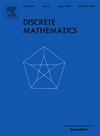The saturation number of C6
IF 0.7
3区 数学
Q2 MATHEMATICS
引用次数: 0
Abstract
A graph G is called -saturated if G is -free but is not for any . The saturation number of , denoted , is the minimum number of edges in a -saturated graph on n vertices. Finding the exact values of has been one of the most intriguing open problems in extremal graph theory. In this paper, we study the saturation number of . We prove that for all , which significantly improves the existing lower and upper bounds for .
C6的饱和数
如果G是无ck的,但是对于任何e∈e (G), G+e都不是,那么图G被称为ck饱和的。Ck的饱和数,记为sat(n,Ck),是在n个顶点上的Ck饱和图的最小边数。求出sat(n,Ck)的精确值一直是极值图论中最有趣的开放问题之一。本文研究了C6的饱和数。我们证明了对于所有n≥9,4n/3−2≤sat(n,C6)≤(4n+1)/3,显著改进了已有的sat(n,C6)的下界和上界。
本文章由计算机程序翻译,如有差异,请以英文原文为准。
求助全文
约1分钟内获得全文
求助全文
来源期刊

Discrete Mathematics
数学-数学
CiteScore
1.50
自引率
12.50%
发文量
424
审稿时长
6 months
期刊介绍:
Discrete Mathematics provides a common forum for significant research in many areas of discrete mathematics and combinatorics. Among the fields covered by Discrete Mathematics are graph and hypergraph theory, enumeration, coding theory, block designs, the combinatorics of partially ordered sets, extremal set theory, matroid theory, algebraic combinatorics, discrete geometry, matrices, and discrete probability theory.
Items in the journal include research articles (Contributions or Notes, depending on length) and survey/expository articles (Perspectives). Efforts are made to process the submission of Notes (short articles) quickly. The Perspectives section features expository articles accessible to a broad audience that cast new light or present unifying points of view on well-known or insufficiently-known topics.
 求助内容:
求助内容: 应助结果提醒方式:
应助结果提醒方式:


